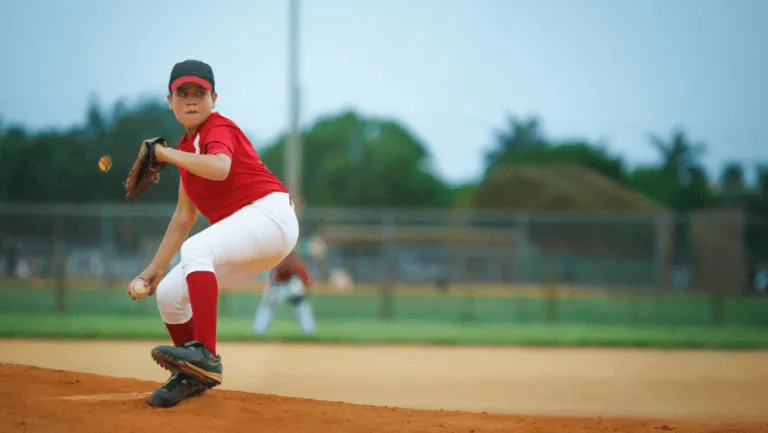Shoulder pain is a common issue among baseball pitchers. It can limit performance and cause discomfort in the shoulder area when throwing the ball and is especially a problem for pitchers.
Shoulder pain is a common issue for pitchers, especially as the person reaches a point where they are asked to throw hard for long periods of time as they start to get older. As a pitcher reaches their teenage years, they are beginning to use more of their body in order to throw harder to play at a higher level. That torque and repetitive use of the arm to throw 70-100 pitches a game can put major stress on the body.
Overuse and poor technique can lead to shoulder impingement, tendinitis, and shoulder instability which are all conditions that cause shoulder pain.
Improper warm-up practices, lack of shoulder strengthening and mobility exercises, and incorrect pitching mechanics can also increase the risk of shoulder injury in pitchers.
For that reason, it is important for pitchers to properly warm up before throwing, work on shoulder strength and mobility exercises regularly and practice good form when it comes to pitching mechanics to reduce their chances of experiencing shoulder pain.
In this blog, we hope to give you a handful of tips that can help you avoid shoulder issues, as well as some tips on how to treat shoulder pain should you experience any when throwing the baseball.
3 Tips to Help Prevent Shoulder Pain When Throwing
1. Stretch and warmup before throwing
Proper stretching before throwing a baseball is important for both short-term and long-term performance. Before throwing, it is important to stretch and warm up the shoulder muscles as this will help to prevent injury and will maximize the ability of the muscles used to throw the ball.
Stretches should focus on the arms, chest, shoulders, and core muscles – including exercises such as arm circles, overhead shoulder stretches, and trunk rotations.
You must stretch your core muscles, legs, and trunk to help in the power you are providing your throwing arm. Throwing should not be all arm, and you will notice that the pain felt while throwing can be reduced if you use your core and legs to throw as well. It also keeps you from having arm issues later.
Stretching regularly can also increase flexibility in these areas which helps to reduce the risk of injury when throwing a baseball. Taking time for proper stretching before pitching can help maximize your performance on the field.
2. A throwing program after time away from baseball
One of the leading causes of injury to the throwing arm in baseball is jumping immediately on the mound or throwing long distances when just getting back in season. The preseason is a great time to start your throwing program and routine, especially for pitchers or people that have had arm problems prior.
Many baseball players take breaks between seasons. Not everyone has the benefit of living somewhere that it is warm and you can play year-round.
It is important to start working the arm back into shape so that you can avoid issues down the road, so having a throwing program can help you prevent the shoulder pain that will keep you out for an extended period of time.
There are many throwing programs out there, but most recommend starting to throw them every other day before the start of the season. Short toss and then work your way into long toss after loosening up the arm. Do this three times a week and start about 8 weeks before the season.
Then start to increase the number of days you throw, with proper rest and icing in between throwing. 10-15 minutes of ice on both, the shoulder and elbow, will help tremendously in preventing injury.
Do not jump on the mound early and immediately start hitting a high pitch count. When you do feel that your arm is ready to start pitching and throwing bullpens, put a limit on the number of pitches to start the season. Work your body up to the higher pitch counts and stop should you start to feel any discomfort or notice that the arm is fatigued.
3. Rest and Recover
After pitching, it is important to rest the arm and take time for recovery. Rest, ice, and compression is a good way to reduce inflammation and soreness in the shoulder muscles after throwing a baseball.
Resting can help give your body time to recover from any fatigue or strain caused by pitching. Applying ice packs will also help to relieve pain and swelling in the arm muscles as well as speed up recovery time after a game or outing.
Additionally, wrapping an elastic bandage around the arm can help with compression which further helps to reduce swelling and tenderness.
Taking care of your arm after throwing is just as important as stretching and loosening it up before practice or a game. It is the part that many ignore when it comes to throwing a baseball. The recovery is important because it causes a lot of stress on the body to throw a ball at a high velocity.
Having a throwing program in place after you have pitched in a game and are working to throw in the next one can help as well. You want to give the arm a proper rest, and most pitchers will be slated to throw again in 5 days or so depending on the situation, and you will want to make sure you are fresh for the next outing.
3 Tips to Help Treat Your Shoulder Pain As A Result of Throwing the Ball
1. Rest and Ice
While these are things you can do to prevent injury, sometimes the shoulder pain can be reduced or even eliminated if you rest and ice your arm. Most, if not all, players don’t want to hear the words, “shut it down.” But, in many cases that is exactly what the arm needs to recover.
Time away from throwing the baseball could be what your arm needs to recover.
As you start to get back into baseball activities and think about starting a throwing program again, it won’t hurt to stretch, ice, and do some exercises to strengthen the muscles in the core, legs, and arm to help you tackle the pain. Some of the shoulder pain a pitcher might be experiencing comes from the muscles not being strong enough that support throwing the baseball.
2. Adjusting Mechanics
Maybe the pain is felt because of poor throwing mechanics. If the elbow is dipping under the shoulder or they are leading with the elbow when throwing you are putting more stress on the elbow and that can result in arm issues.
Also, many pitchers experience a time in their career when they are told that they are throwing with “all arm”. All-arm throwing means that the player throwing the ball is not using the core or trunk of their body to supply the needed support for throwing. The core and legs are where you get a lot, if not all, of your torque and power when throwing. If your pitcher is using the arm trying to increase the speed and power through the should, then this will cause pain and injury.
This is why we put this in treatment. You can treat shoulder pain by identifying bad throwing mechanics and often create relief on the arm by having the proper mechanics.
3. Physical Therapy
Talking to the throwing mechanics mentioned above, a player must understand the importance of how to use their body to maximize potential, but also reduce pain and injury. In baseball, many of the players we see with arm issues are because of overuse, bad mechanics, or a combination of both. We can help with all these things.
Physical therapy is a great place to come if you are experiencing pain in your throwing arm. It is better getting ahead of the issues that have come up rather than working through them and hoping they go away in time.
We understand that players might feel hesitant to alert someone that there could be a problem and nobody wants to miss time away from the game they love. However, if we can get out pitchers and players to understand that identifying the problem earlier will keep them on the field or get them back on the field sooner, than if they ignore the problem and try to play through it.
Come visit us and take advantage of our $54 Pitcher Assessment just before the season starts. We want to make sure that you or your player have a healthy start to the season. The assessment allows for us to review injury history, review their throwing program, assess their baseball specific movements including posture, shoulder, elbow, hip, and trunk range of motion, as well as shoulder and grip strength.
We utilize digital technology to take our measurements for accuracy and so we can establish a baseline to track throughout their season and season over season in order to prevent injury and identify places that are a cause for concern and address those as well.
Would You Like Physical Therapy to Help Get Answers About Your Shoulder Pain While on the Mound
Zone Physical Therapy would love to help answer your questions about your shoulder pain or pain associated with baseball. As baseball season is just around the corner, we want your player as healthy as possible and ready to go for opening day. The $54 Pitcher Assessment is a fantastic way to identify the issues you might have in your mechanics, and give you answers to any pain you might be feeling when throwing the ball.
In our clinic, we can assess any issues that you or the player might be having that are keeping them from enjoying the game they love, with as little to no pain as possible.
Our team has helped so many patients with shoulder pain, and we would love to help you stay on the field this spring and summer!
To arrange a visit to our office and talk about your shoulder pain- Request An Appointment or call us on (864) 351-7254.



